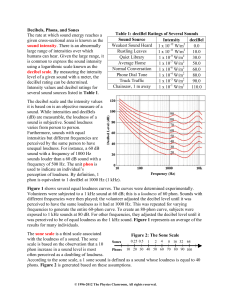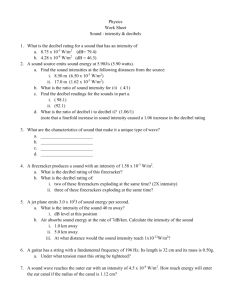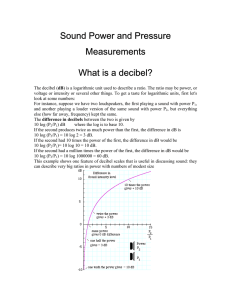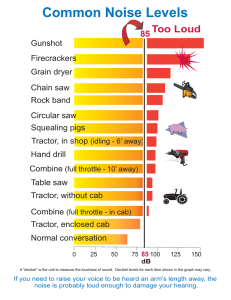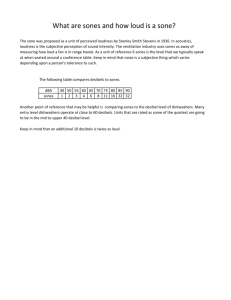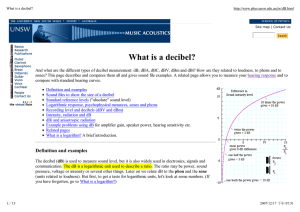Decibels, Phons, and Sones The rate at which sound energy
advertisement
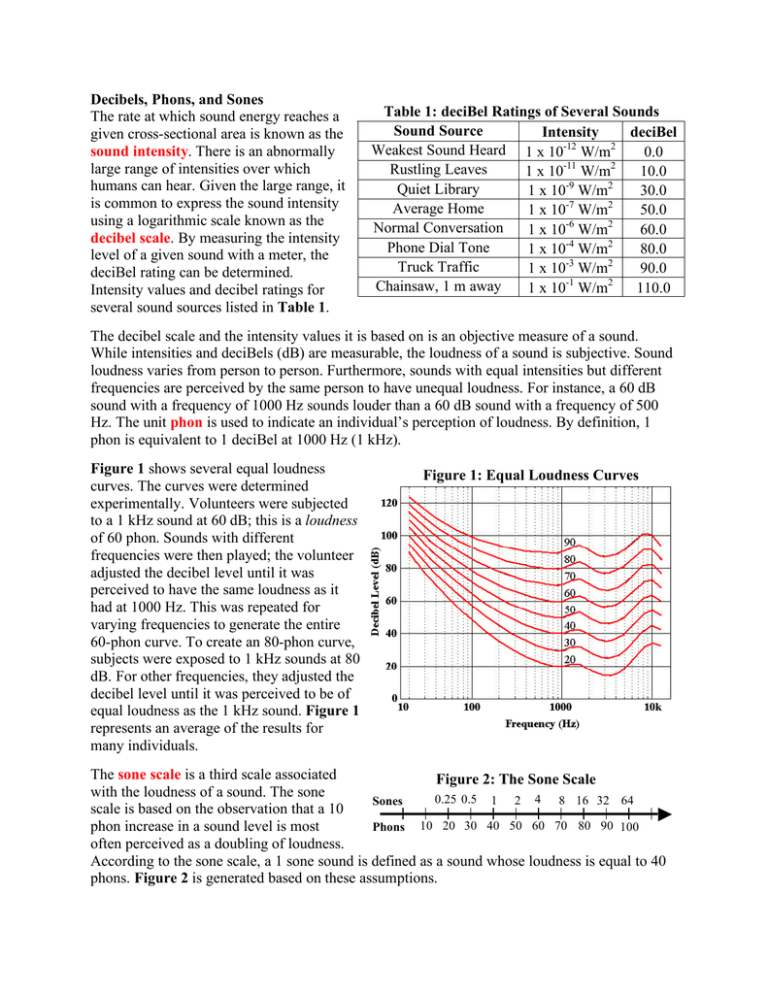
Decibels, Phons, and Sones The rate at which sound energy reaches a given cross-sectional area is known as the sound intensity. There is an abnormally large range of intensities over which humans can hear. Given the large range, it is common to express the sound intensity using a logarithmic scale known as the decibel scale. By measuring the intensity level of a given sound with a meter, the deciBel rating can be determined. Intensity values and decibel ratings for several sound sources listed in Table 1. Table 1: deciBel Ratings of Several Sounds Sound Source Intensity deciBel Weakest Sound Heard 1 x 10-12 W/m2 0.0 -11 2 Rustling Leaves 1 x 10 W/m 10.0 Quiet Library 1 x 10-9 W/m2 30.0 -7 2 Average Home 1 x 10 W/m 50.0 -6 2 Normal Conversation 1 x 10 W/m 60.0 -4 2 Phone Dial Tone 1 x 10 W/m 80.0 -3 2 Truck Traffic 1 x 10 W/m 90.0 -1 2 Chainsaw, 1 m away 1 x 10 W/m 110.0 The decibel scale and the intensity values it is based on is an objective measure of a sound. While intensities and deciBels (dB) are measurable, the loudness of a sound is subjective. Sound loudness varies from person to person. Furthermore, sounds with equal intensities but different frequencies are perceived by the same person to have unequal loudness. For instance, a 60 dB sound with a frequency of 1000 Hz sounds louder than a 60 dB sound with a frequency of 500 Hz. The unit phon is used to indicate an individual’s perception of loudness. By definition, 1 phon is equivalent to 1 deciBel at 1000 Hz (1 kHz). Figure 1 shows several equal loudness curves. The curves were determined experimentally. Volunteers were subjected to a 1 kHz sound at 60 dB; this is a loudness of 60 phon. Sounds with different frequencies were then played; the volunteer adjusted the decibel level until it was perceived to have the same loudness as it had at 1000 Hz. This was repeated for varying frequencies to generate the entire 60-phon curve. To create an 80-phon curve, subjects were exposed to 1 kHz sounds at 80 dB. For other frequencies, they adjusted the decibel level until it was perceived to be of equal loudness as the 1 kHz sound. Figure 1 represents an average of the results for many individuals. Figure 1: Equal Loudness Curves The sone scale is a third scale associated Figure 2: The Sone Scale with the loudness of a sound. The sone 0.25 0.5 1 2 4 8 16 32 64 Sones scale is based on the observation that a 10 Phons 10 20 30 40 50 60 70 80 90 100 phon increase in a sound level is most often perceived as a doubling of loudness. According to the sone scale, a 1 sone sound is defined as a sound whose loudness is equal to 40 phons. Figure 2 is generated based on these assumptions. Questions: 1. Which statement accurately describes the mathematical relationship between the intensity of a sound and the decibel rating? a. The decibel rating is the intensity value multiplied by 10. b. The decibel rating doubles every time the intensity rating increases by 1000. c. The decibel rating increases by 10 dB for every 10-fold increase in the intensity level. d. The decibel rating is 10 times the absolute power of the exponent on 10 for the intensity level. 2. How is the decibel scale different than the phon scale? a. All sounds have different decibel rating but the same phon rating. b. The decibel scale is an objective measure of a sound; the phon scale is more subjective. c. There is no limit on the decibel scale; the phon scale is limited to a smaller range of numbers. d. The decibel scale measures the loudness of sound; the phon scale measures a person's perceptions. 3. What would be the phon rating of a 100 Hz sound that has a decibel rating of 60 dB? a. 30 phons b. 35 phons c. 40 phons d. 60 phons 4. Based on the information ion Figure 2, how many times louder would a typical person perceive a 70 phon sound to be compared to a 40 phon sound? a. 0.5 times louder b. 3 times louder c. 8 times louder d. 30 times louder 5. A sound has an intensity level of 1 x 10-2 W/m2 and a frequency of 200 Hz. Use Table 1, Figure 1, and Figure 2 to determine its rating on the Sone Scale. a. Approximately 10 sones b. Approximately 64 sones c. Approximately 100 sones d. Approximately 110 sones

